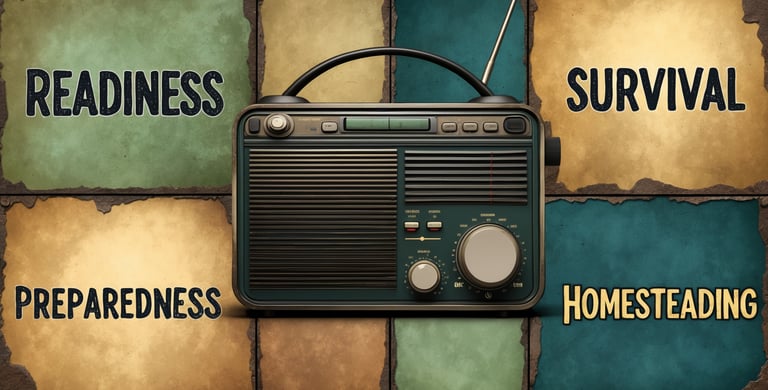Preparedness: Communications Preparedness
Radio, Signaling, and Staying Connected in Collapse
4FORTITUDER - READINESS, SURVIVAL, PREPAREDNESS, HOMESTEADING
Preparedness: Communications Preparedness
Radio, Signaling, and Staying Connected in Collapse
“In war, the first casualty is truth—but the second is communication.”
— Anonymous Field Commander
When Silence Reigns, Panic Breeds
The power may stay off. The phones may go dark. The grid may fracture. But your duty remains: to lead, to connect, to rally, to report. In that moment, the prepared man does not curse the silence—he speaks into it with signal, code, and clarity.
Communication preparedness is not about high-tech gadgets. It’s about knowing what to say, how to say it, and through what means—when everything else is falling apart.
This is the realm of relational logistics—because information isn’t just power. It’s survival.
Core Knowledge Foundation: The Four Layers of Collapse Communication
Family Comms and Rally Plans – Internal clarity when digital contact fails.
Short-Range Radios and Signaling – Neighborhood- to block-scale communication.
Mid-to-Long Range Comms – City-to-city and regional contact.
Code, Silence, and Communication Security – Protecting the message and controlling its reach.
Misconception Warning: Owning a Baofeng doesn’t make you prepared. Without a license, a battery plan, and training—it’s just plastic.
1. Family Comms and Rally Plans
Goal: Ensure every member knows how to act, where to go, and what to do when contact is lost.
What to Implement:
Primary Rally Point (PRP): Home base, with 2 backups
Check-In Times: 9am, 3pm, 9pm standard
Phrase Protocol: “All good” = GREEN | “Need help” = RED | “Can’t talk now” = AMBER
Tools:
Paper contact lists
Laminated comms plan in every vehicle and bug-out bag
Dry erase board for message-leaving in secure locations
Drill: Cut phones for 12 hours. Simulate outage. Attempt reconnection at PRP or via backup plan. Note time gaps and confusion.
2. Short-Range Radios and Signaling
Goal: Maintain voice or signal contact across your immediate environment—without reliance on cellular or internet.
Gear:
FRS/GMRS Radios (2–5 miles): No license for FRS; GMRS requires one
Walkie-Talkies with NOAA Channels: Weather alerts + basic contact
Handheld Ham (Baofeng UV-5R, etc.): Extendable to 10+ miles with repeaters
Signal Practice:
Whistles: 3 blasts = distress
Flashlight blinks: 1 (OK), 2 (wait), 3 (come)
Colored flags, door markings, chalk signs
Repeaters: Learn location of nearby radio repeaters (can drastically extend range). Many are published online—print maps for offline use.
Drill: Simulate a nighttime perimeter breach. Communicate only with radio and flashlight. Log delays, misunderstandings, and dead zones.
3. Mid-to-Long Range Comms
Goal: Get information in and out of your region when normal systems are down.
Tools:
Ham Radio (HF Bands): Up to hundreds of miles
CB Radio (27 MHz): Truckers, convoy communication
Shortwave Receiver: Listen to global news without internet
Satellite Messenger (Garmin inReach, SPOT): Send emergency messages where cell service fails
Licensing:
Technician-level Ham license (for legal operation in peacetime)
Online courses + local Ham radio clubs available nationwide
Practice with weather monitoring and off-grid check-ins
Drill: Initiate long-range radio contact with a known friend 100+ miles away. Practice logging weather, road closures, or events.
4. Code, Silence, and Communication Security
Goal: Ensure your messages are clear to allies—but obscure to threats.
How to Protect Your Comms:
Brevity Codes:
"Tango 3" = 3-person team moving
“Red Echo” = Evacuate now
“Delta Zero” = No contact, full silence
Callsigns: Assign names to team/family (e.g., “Falcon,” “Echo,” “Baseplate”)
Directional Communication: Speak in reference to locations, not specifics (e.g., “North Trail secured” vs. “We cleared Main Street”)
COMSEC Habits:
Change channels daily
Don’t repeat names or locations
Practice “Listen-First” protocol before transmitting
Drill: Run a 3-hour silent operations window. Communicate only via code and light/sound signal. Simulate eavesdroppers and build discipline.
Advanced Insights: The Power of the Message Over the Medium
A tool is only as valuable as the message it carries. In collapse, the man who speaks clearly wins trust, moves people, and survives.
Train:
Brevity: “Say little, mean much.”
Tone: Calm = control
Repetition: Clarity prevents chaos
Historical Anchor: WWII Resistance Radio Operators
Often young women or tradesmen. Risked execution to transmit codes to allies. They spoke briefly, clearly, and knew the value of one message, rightly sent.
Critical Perspectives: Tech Reliance and the "I’ll Just Call" Mentality
Adversarial Viewpoint:
“I’ll just use my cell. If things are really bad, someone will restore service.”
Response:
In a true emergency, systems prioritize government and law enforcement signals. Civilians are often throttled or cut. Even in minor blackouts, towers fail and lines flood. If you can’t communicate off-grid, you’ve lost your reach—and your power.
Wisdom and Warning Duality
When Followed: You guide calmly, report clearly, and call help when others are silent. You move as a unit.
When Ignored: You wait. You guess. You fear the silence—and so does your family.
Strategic Crossroad: Will you send the signal—or be the man left waiting for one?
Final Charge & Implementation
Brother, communication isn’t luxury—it’s leadership. It’s the difference between rallying a defense or being picked apart one by one. Between reaching out—or dying quietly.
In collapse, you speak. Or you disappear.
Start Now:
Build the 4-Layer Comms Readiness Kit
“If you cannot be heard, you cannot be helped.”
Family rally plan + printed codes
Handheld radios (programmed + charged)
Shortwave receiver + satellite backup
COMSEC guide + drill cards
Initiate the Monthly Comms Simulation
“The signal is sacred. Guard it. Practice it.”
Radio check with trusted group
One blackout night: no phones, radios only
Teach children 3 codes and 1 silent signal
Update channel maps and callsign rosters
Strategic Reflection:
If you lost your phone tonight, could you still speak to your tribe?
Existential Challenge:
Will your words lead people through the storm—or will your silence deepen it?
Be the man who speaks when it counts. Who knows the right words. Who builds systems of signal when the world returns to noise and shadows.
“He who controls the message controls the moment. In collapse, be the one they listen to.”


